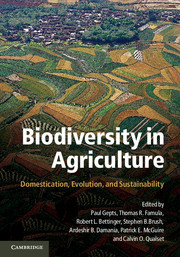Book contents
- Frontmatter
- Contents
- Tables
- Figures
- Foreword
- Contributors
- Acknowledgments
- Introduction: The Domestication of Plants and Animals: Ten Unanswered Questions
- 1 The Local Origins of Domestication
- Section I Early Steps in Agricultural Domestication
- Section II Domestication of Animals and Impacts on Humans
- Section III Issues in Plant Domestication
- Section IV Traditional Management of Biodiversity
- 17 Ecological Approaches to Crop Domestication
- 18 Agrobiodiversity Shifts on Three Continents Since Vavilov and Harlan: Assessing Causes, Processes, and Implications for Food Security
- 19 Indigenous Peoples Conserving, Managing, and Creating Biodiversity
- 20 Land Architecture in the Maya Lowlands: Implications for Sustainability
- 21 Agrobiodiversity and Water Resources in Agricultural Landscape Evolution (Andean Valley Irrigation, Bolivia, 1986 to 2008)
- Section V Uses of Biodiversity and New and Future Domestications
- Index
- References
19 - Indigenous Peoples Conserving, Managing, and Creating Biodiversity
Published online by Cambridge University Press: 05 June 2012
- Frontmatter
- Contents
- Tables
- Figures
- Foreword
- Contributors
- Acknowledgments
- Introduction: The Domestication of Plants and Animals: Ten Unanswered Questions
- 1 The Local Origins of Domestication
- Section I Early Steps in Agricultural Domestication
- Section II Domestication of Animals and Impacts on Humans
- Section III Issues in Plant Domestication
- Section IV Traditional Management of Biodiversity
- 17 Ecological Approaches to Crop Domestication
- 18 Agrobiodiversity Shifts on Three Continents Since Vavilov and Harlan: Assessing Causes, Processes, and Implications for Food Security
- 19 Indigenous Peoples Conserving, Managing, and Creating Biodiversity
- 20 Land Architecture in the Maya Lowlands: Implications for Sustainability
- 21 Agrobiodiversity and Water Resources in Agricultural Landscape Evolution (Andean Valley Irrigation, Bolivia, 1986 to 2008)
- Section V Uses of Biodiversity and New and Future Domestications
- Index
- References
Summary
There is a constant barrage of information about people destroying “nature”. Just as an example, to quote from the National Science Foundation (emphases added):
Studies in Europe have drawn from 10,000 years of human occupation to illuminate human and environmental causes for increased erosion and desertification of the northern Mediterranean region. (NSB 99–133 1999).
And
...to better understand the human dimensions of deforestation... an interdisciplinary team... has combined theories of human decision-making about land cover conditions with detailed analyses of field sites. (NSB 00–22 2000)
We need to counter such statements with examples of people who act successfully as conservationists, managers, and creators of biodiversity. These could help us learn to solve many of the environmental problems we face and the issues we address (Fenstad et al. 2002).
- Type
- Chapter
- Information
- Biodiversity in AgricultureDomestication, Evolution, and Sustainability, pp. 426 - 444Publisher: Cambridge University PressPrint publication year: 2012
References
- 8
- Cited by



